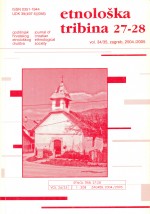O odnosu urbanog i etničkog identiteta: Primjer Talijana i Hrvata u gradu Krku
On the Relation of Urban and Ethnic Identities: The Example of Italians and Croats in the City of Krk
Author(s): Ruža BonifačićSubject(s): Theatre, Dance, Performing Arts, Customs / Folklore, Music, Recent History (1900 till today), Cultural Anthropology / Ethnology, Identity of Collectives
Published by: Hrvatsko etnološko društvo
Keywords: urban and ethnic identity; Italians and Croats; brass band; urban folk dances; urban folk songs;
Summary/Abstract: The island of Krk in the Croatian part of the Northern Adriatic has a population of 18,500, predominantly Croatian. Five of its 68 settlements have been traditionally regarded as towns (at least in the medieval sense) for about a millennium. Out of these, the city of Krk has had an exceptional role and history, resulting in a specific identity. While the remaining four were founded and populated by the Croats, who colonized the island presumably in the 8th century, the city of Krk had been the local administrative centre of the Roman Empire, with Roman population. With the Croatian colonization, the surviving Roman population of the island took refuge in the city of Krk. However, the Croats moved in as well, and coexistence prevailed. For quite a few centuries the city of Krk was the seat of Venetian rule, whether indirect (via the local Croatian princes, the vassals of Venice) or direct (1480-1797), which introduced an additional Romance element. What we observe today are the remnants of the resulting complex identity relying predominantly on the exclusivity of Romance (Italian) and urban, as opposed to Slavic (Croatian) and rural. Despite a certain antagonism between the Italians and Croats, a togetherness emerged; in the course of the 20th century, they developed a specific informal minority group in which their urban identity became even more material than their ethnic one. Currently they refer to themselves as "stari Vejani" ("old Veians", from Veglia, the Italian name for Krk). They are bilingual, speaking among themselves a local variant of the Venet idiom, irrespective of their ethnicity. This paper is based rather on the reminescences of "old Veians" than on the reality of this presently small community. Out of various musical traits of this community three of them are substantial for disclosing and defining their identity, viz. the formally gathered, classically trained players in the brass band, the informally gathered, singers who perform urban folk homophonic songs in three or four parts, predominantly in major and in Italian, and the dancers of the old and revived Krk urban folk dances manfrina and šotiš. With these they differ considerably from the rest of the island population.
Journal: Etnološka tribina : Godišnjak Hrvatskog etnološkog društva
- Issue Year: 34/2005
- Issue No: 27-28
- Page Range: 61-77
- Page Count: 17
- Language: Croatian

